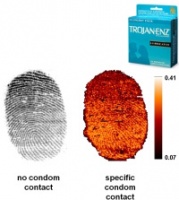The technique is claimed to provide proof of contact with a condom, placing someone accused of a sexual offence at the scene of the crime.
There has been an increase in the use of condoms by sexual offenders, likely due to both to the risk of sexually transmitted diseases and to prevent the transfer of DNA evidence.
The technique used by researchers at the university’s Biomedical Research Centre (BMRC) can detect condom lubricant on fingermarks left by a suspect at a crime scene.
This can link a suspect, identified by their fingermark, to the crime in one analysis and can aid police in proving that an offence has taken place. It is hoped the technique might be used to match lubricant found on a fingermark with residues from vaginal swabs collected from the victim.
Researchers successfully detected lubricant from two widely available condom brands on fingermarks for the first time, and the technique was proven to be successful even on fingermarks left several weeks before analysis.
The academics hope the technique can eventually be used to identify distinctive lubricants that could indicate a specific condom manufacturer and possibly even a particular brand. This would allow the forensic case to be profiled in an even stronger way.
To detect the lubricants, the researchers used matrix-assisted laser desorption/ionisation (MALDI) imaging, a soft ionisation technique used in mass spectrometry, allowing the analysis of biomolecules and large organic molecules which tend to be fragile and to fragment when ionised by more conventional ionisation methods.
Dr Simona Francese from the university’s BMRC said: ‘Offenders are increasingly aware of forensic issues and it is common now for condoms to be used and removed from the scene of a sexual assault. However, they are less likely to consider the possibility of lubricant transferring onto their fingertips and then into fingermarks left at the scene.

’If condom lubricant can be detected in fingermarks it would improve the evidence for the prosecution by establishing the assailant’s presence at the scene and, crucially, having had contact with a condom. This would enable forensic scientists to provide further support to the evidence in alleged cases of sexual assault.’





Glasgow trial explores AR cues for autonomous road safety
They've ploughed into a few vulnerable road users in the past. Making that less likely will make it spectacularly easy to stop the traffic for...